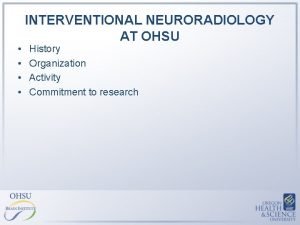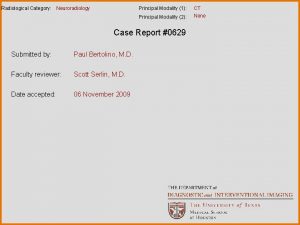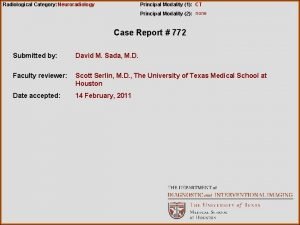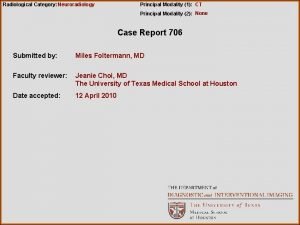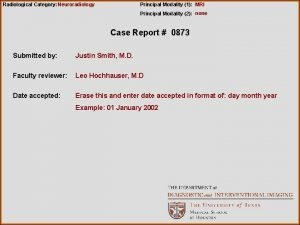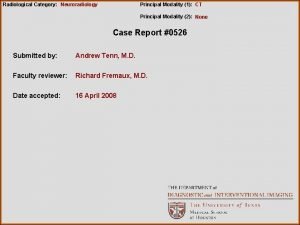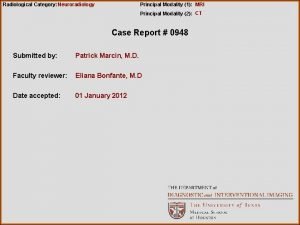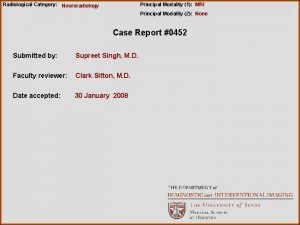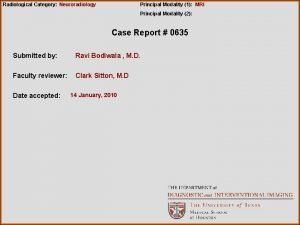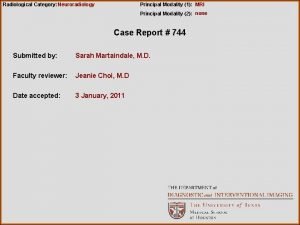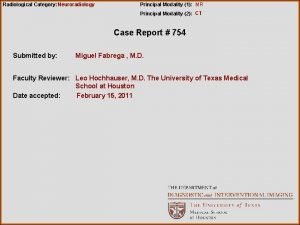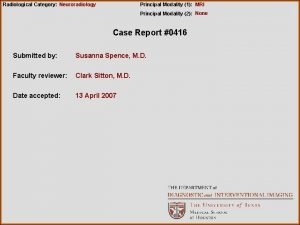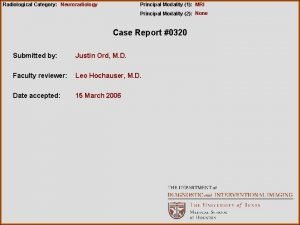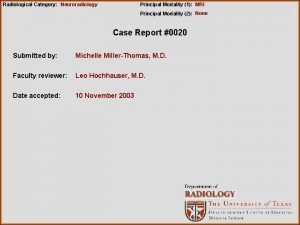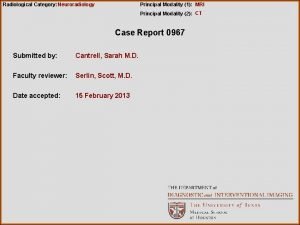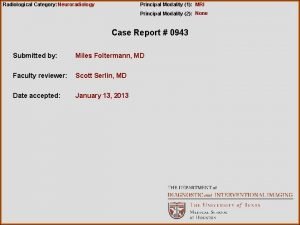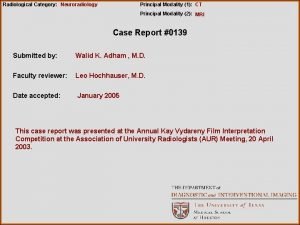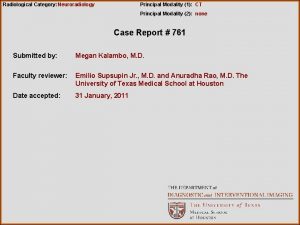Radiological Category Neuroradiology Principal Modality 1 CT Principal




















- Slides: 20

Radiological Category: Neuroradiology Principal Modality (1): CT Principal Modality (2): MRI Case Report #0626 Submitted by: Joshua Franklin, M. D. Faculty reviewer: Clark Sitton, M. D. Date accepted: 28 April 2009

Case History 45 year old female with several month history of headaches unresponsive to conservative management. Starting 2 weeks prior to presentation the headaches increased in intensity with new onset of nausea, photophobia, and gait instability.

Radiological Presentations Figure 1 Figure 2 Figures 1 -2: Axial CT images at the level of the 3 rd Ventricle

Radiological Presentations Figure 3 Figure 4 Figures 3 -4: Axial CT images at the level of the midbrain

Radiological Presentations Figures 5: Same image as Figure 1 with bone window.

Radiological Presentations Figure 6 : Axial T 1 W image at the level of the midbrain Figure 7 : Sagittal T 1 W image near the midline

Radiological Presentations Figures 8: Post gadolinium Axial T 1 W image through the midbrain

Test Your Diagnosis Which one of the following is your choice for the appropriate diagnosis? After your selection, go to next page. • Lipoma • Teratoma • Epidermoid • Germinoma • Dermoid

Findings and Differentials Findings: - An irregular, 3 cm mass is just posterior to the midbrain tectum and clearly below the internal cerebral veins on the sagittal MRI image placing it in the pineal region and quadrigeminal cistern. The anterior portion of the lesion is low in density on CT scan and demonstrates hyperintense T 1 W signal on MRI consistent with fat. The posterior portion of the lesion is ossified, as seen on figure 5 (the bone windowed CT image), and extends over the left superior cerebellar hemisphere. There is mild contrast enhancement on the post contrast T 1 W MRI image especially around the periphery of the ossified component. -There is mild vasogenic edema in the left cerebellum surrounding the mass. The mass also compresses the cerebral aqueduct leading to hydrocephalus with enlargement of the lateral and third ventricles.

Findings and Differentials: • Teratoma • Dermoid • Epidermoid • Lipoma

Discussion Pineal region masses are relatively uncommon making up only 1 -3% of all intracranial masses in the United States. Of the pineal masses, germ cell tumors such as germinomas and teratomas are the most common, accounting for nearly 60%. Tumors of pineal cell origin, pineocytomas and pineoblastomas are the next most common, accounting for most of the remaining 40%. Other neoplasms originating in the pineal region are rare, but several non-neoplastic masses may be found here including pineal cysts, intracranial lipomas, arachnoid cysts, dermoids, and epidermoids. 1 The key finding in this case is the presence of fat in the lesion, which allows focusing of the differential to include only those lesions that produce some form of lipid, namely teratomas, dermoids, lipomas, and epidermoids. Of this list only teratomas have malignant potential and even these are usually histologically mature and benign, especially in the pineal region 2. Differentiating these lesions, especially dermoids and teratomas, based on imaging can be difficult, and is not always possible. The following discussion will highlight some of the important considerations when attempting to make a distinction between the fat containing intracranial masses.

Discussion Teratomas are the second most common pineal region mass, accounting for approximately 15% of all masses (only germinomas are more common) 1. They are neoplasms of pluripotential ectopic germ cells that have been misplaced during development and usually become embedded near midline structures. The neoplastic ectopic germ cells then produce tissues that usually represent two or more of the embryonic germ cell layers: the endoderm, mesoderm, and ectoderm. 2 Teratomas usually present in childhood in extragonadal locations such as the sacrococcygeal region, mediastinum, and head, whereas most adult teratomas are gonadal. 2 Teratomas are classified as either mature or immature and can be either benign or malignant. Mature teratomas can produce almost any type of adult tissue, whereas immature teratomas produce fetal embryonic and extraembryonic tissues. The lesions may also be totally encapsulated, partially encapsulated, or unencapsulated and locally invasive. 1 Most pineal region teratomas are benign and mature histologically. 2

Discussion The diagnosis of teratoma is suggested when a tumor contains both fat and calcifications. The calcifications may be dystrophic, true sites of ossification, or even well formed teeth. On imaging, these lesions will appear as heterogeneous, multiloculated lesions with variable mixtures of soft tissue, fluid, fat, and calcification. Administration of contrast may demonstrate irregular enhancement, however the pattern of enhancement depends on the specific composition. The soft tissue components will enhance, however the calcified and fatty components will not 3. It should be noted that while lipid and calcifications are characteristic, they are not found in all teratomas. The absence of these findings therefore makes a teratoma less likely, but cannot be used to exclude the diagnosis. 1, 2, 3

Discussion Dermoids and epidermoids are non-neoplastic inclusion cysts with an epithelial lining. Intracranial dermoids and epidermoids are congenital lesions that likely arise early in development when surface ectoderm fails to completely separate from the underlying neural tube and becomes sequestered inside the embryo. 2 Epidermoids have a thin stratified squamous epithelial lining that contains no dermal appendages. They therefore contain only desquamated debris composed mostly of keratin and cholesterol. They are thought to arise later in development than dermoids and are therefore more frequently lateral in location, off of the midline. Most commonly, intracranial epidermoids are found in the cerebellopontine angle cistern, although they can also be seen in other locations, including the suprasellar cistern and pineal region. 3 Epidermoids expand slowly and tend to completely fill the CSF space that they occupy, wrapping themselves around adjacent normal structures. One of the main clinical concerns is therefore mass effect caused by the lesion. 3 Another clinical concern is the potential for rupture which can cause a chemical meningitis 2.

Discussion On CT, epidermoids will appear as lobulated unilocular cysts with low attenutation close to that of simple fluid. Attenuation values may be slightly negative secondary to the cholesterol (lipid) content, however low negative attenuation values, like those seen with adipose tissue are uncommon. As the epithelial lining of an epidermoid is very thin and difficult to visualize radiologically, calcifications and contrast enhancement, while occassionally seen, are also uncommon. 2 Similar to epidermoids, dermoids are inclusion cysts with a squamous epithelial lining. Unlike epidermoids, dermoids contain dermal appendages such as hair follicles, sebaceous glands, and sweat glands. They therefore contain not only desquamated debris but also the products of the dermal appendages including hair and sebum. In terms of location, intracranial dermoids are nearly always found in a midline location, which is may be because they arise earlier in development than epidermoids. The most common locations for these lesions are the extra-axial spaces of the posterior fossa and the suprasellar cistern. Less commonly they are found in the pineal region.

Discussion Clinically, the main concerns regarding dermoids, similar to epidermoids, are mass effect and rupture leading to chemical meningitis. A more unique concern is the possibility of dysraphic malformations with a fibrous or fistulous connection to the skin associated more commonly with posterior fossa dermoids. Dermoids with these tracts may become infected and/or lead to infectious meningitis. 2 Dermoids are usually unilocular, midline lesions with a thicker wall than epidermoids. The thicker wall accounts for the more frequent finding of calcifications and enhancement. Since dermoids produce sebum, they commonly demonstrate low negative attenuation values similar to that of adipose tissue. Fat-fluid levels are also common. The fat content of dermoids allows for diagnosis of lesion rupture as lipid droplets will be found in the CSF spaces. 2 The combination of fat and calcium in a dermoid frequently makes differentiation from a teratoma difficult if not impossible. It should also be noted that dermoids may demonstrate only fluid density without macroscopic fat or calcifications making differentiation from epidermoids difficult.

Discussion Intracranial lipomas are congenital lesions composed of histologically normal adipose tisues. They arise secondary to abnormal development of the meninx primitiva, the precursur of the pia mater, arachnoid, and inner layer of the dura. These lesions are generally not expansile masses. Rather than causing mass effect and displacing adjacent vessels and nerves, lipomas surround and incorporate these structures, making surgical removal difficult. 1, 3 While the lesion itself may cause mass effect, the main clinical concern is the commonly associated congenital anomalies. Up to 60% of patients with intracranial lipomas have some form of congenital anomalies with up to 50% demonstrating agenesis of the corpus callosum. 3 Intracranial lipomas are most commonly found in the interhemispheric fissure (50%), the quadrigemeinal plate cistern, the pineal region, the hypothalamic region and the cerebellopontine angle cistern. They appear as homogenous, hypodense lesions on CT with attenutation values in the -30 to 100 range. Calcification may be seen in an intracranial lipoma but these lesions are unlikely to enhance. 1, 3

Discussion In conclusion, when presented with a fat containing intracranial lesion such as the one presented here in the pineal region, 4 major diagnoses should be considered: teratoma, dermoid cyst, epidermoid cyst, and intracranial lipoma. Teratomas are usually composed of tissues from 2 or more of the embryonic germ cell layers and present as masses containing fat and calcium. Epidermoids and dermoids are true ectodermal inclusion cysts. Epidermoids are usually simple appearing cysts with fluid attenuation, while dermoids usually present as slightly more complicated cysts with variable amounts of fluid, fat, and calcium. Finally, intracranial lipomas are congenital lesions composed of histologically normal adipose tissue which are commonly associated with congenital anomalies, especially agenesis of the corpus callosum.

Diagnosis Pathologic Diagnosis: “Mature teratoid tumor. Bidermal mature teratoma with ectodermal and mesodermal but no endodermal derivatives. ” The patient was taken to surgery for removal of the mass due to its mass effect causing hydrocephalus and neurological symptoms.

References 1. Smirniotopoulos JG, Rushing EJ, Mena H. Pineal region masses: Differential diagnosis. Radiographics 1992; 12: 577 -596. 2. Smirniotopoulos JG, Chiechi MV. Teratomas, dermoids, and epidermoids of the head and neck. Radiographics 1995; 15: 1437 -1455. 3. Grossman RI, Yousem DM. Neuroradiology The Requisites. 2 nd ed. Philadelphia, PA: Mosby, 2003; 114 -118, 156 -159, 431 -432.
 Ohsu neuroradiology
Ohsu neuroradiology Erate category 2
Erate category 2 Radiological dispersal device
Radiological dispersal device Tennessee division of radiological health
Tennessee division of radiological health Center for devices and radiological health
Center for devices and radiological health National radiological emergency preparedness conference
National radiological emergency preparedness conference Modality in software engineering
Modality in software engineering Callendreasonlocaluserinitiated
Callendreasonlocaluserinitiated Epistemic modality
Epistemic modality Birad 3
Birad 3 Modality stats
Modality stats Stefan savi
Stefan savi Modality in software engineering
Modality in software engineering Deontic and epistemic modality exercises
Deontic and epistemic modality exercises Modality in software engineering
Modality in software engineering Data modeling fundamentals
Data modeling fundamentals Modality
Modality High modality definition
High modality definition Pacs modality workstation
Pacs modality workstation Short wave diathermy definition
Short wave diathermy definition Sensory vs somatic
Sensory vs somatic
